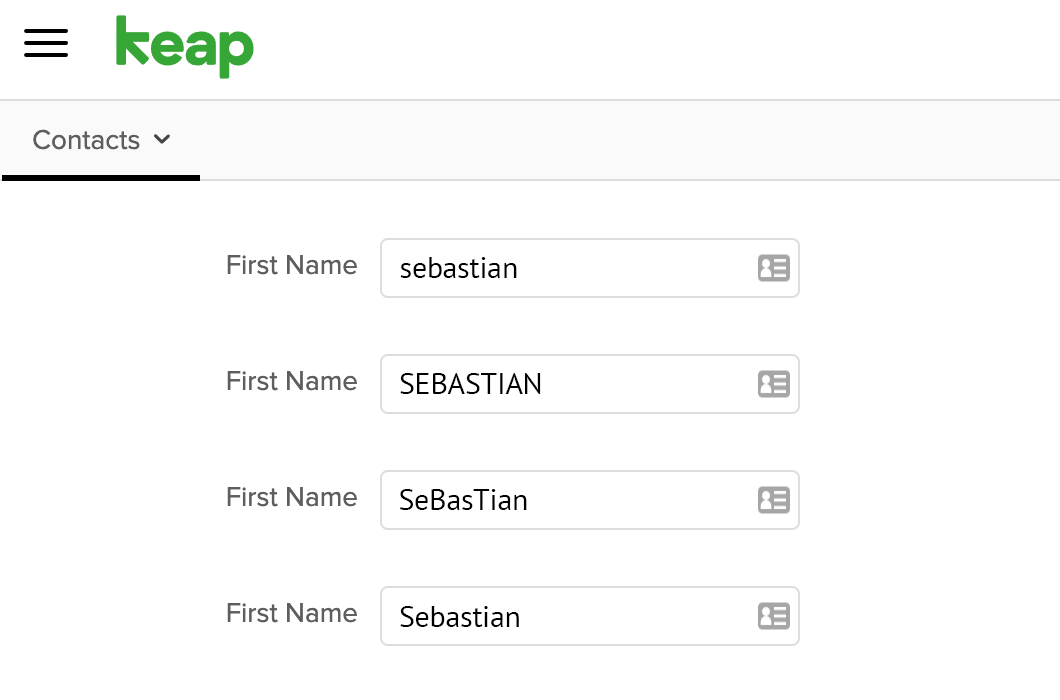Clean Your Keap Contacts Data in 6 Simple Steps

Keap like many other Cloud-based CRMs, bills based on the number of Contact records you have in your app. To make every dollar you spend earn its keep, it's important to pay attention to 'list hygiene' and having current reliable Contact data.
Here are 6 Simple Steps for keeping your Keap Contact data clean
1. Organise and Categorise your Contacts
When entering your Contacts into your CRM you'll want to be able to easily find them again later in useful and usable ways.
Making sure to complete the standard Keap Contact record fields, you're able to avoid some difficult scenarios.
- Having every contact assigned to a Contact Owner helps reassign Contacts when your business changes structure or new sales staff are recruited.
- Adding address details (even if only limited to Country, State or Postcode) helps to find Contacts that exist in geographic locations that correspond to sales regions or territories.
- Making sure that the 'lead status' for a Contact is set, gives you opportunities to make contact based on that context. For example, Leads acquired during a 'trade show' may also be interested to know that you'll be at the same trade show next year.
- Setting the 'birthday' or 'anniversary' date for a Contact gives you a reason to reach out every year on that annual date.
Depending on your industry or niche you may have set up custom fields that organise or categorise your Contacts. If you've gone to the effort to do this, then make sure they are all getting filled.
- 'Personas' are a popular way to internally categorise types of leads and customers and help to identify when someone doesn't really fit your business or identify a new niche opportunity.
- 'Mindsets' are another useful internal organising type to categorise Contacts based on emotional responses or attitudes; help to prepare your team with the best way to communicate, determine urgency, format preferences and many other experiential attributes in a pre-sales call or sales visit.
- 'Motivators' (triggers and events that cause decisions to be made) are usually business specific proprietary classifying schemes intended for high sales conversion. Whole sales campaigns can be designed to target Contacts categorised by 'Motivators'.
In today's personal data and privacy aware world, occasionally asking your Contacts to review and update their data and communications preferences (minus your custom fields), is not only a great practice to get into; it is fast becoming 'the norm' and expected.
2. Cycling through your Keap Contacts
It is important to remember that the modern CRM is a dynamic thing that benefits most when actively used.
ideally your sales, marketing, admin and other teams should be cycling through their Contacts regularly. Making contact to check addresses are current and email doesn't bounce, that Contacts are engaging with communications and that the information you have in the Contact record is up-to-date and the latest.
Each team needs its own communication plan that regularly communicates with Contacts. For example, the admin team needs a plan that keeps on top of things like dates (for contracts, schedules, tenders and other documents, anniversary dates etc), the sales team may require a plan that checks for changes (in contact details, fulfilment preferences, satisfaction ratings etc), while the marketing team might need a plan that confirms engagement (campaigns are being seen, offers are being received, brand recognition and reach are as anticipated etc).
These communication plans are 'evergreen' - that means they happen automatically and annually for the lifetime of the Contact in your CRM. They are the backbone of your constant process for verifying the Contact data, generating lists and identifying any Contacts to be deleted; when necessary.
3. Searchable structured Contact data
Pressure and stress are the most common cause of 'bad data' in a CRM ... The salesperson manually updating a Contact email or address while on the phone talking to a prospect is a familiar story.
Unfortunately, machines (AI, software, database search algorithms and the like) are really dumb - they need the data that they work with to be 'clean' and consistent - 'good data'. It's one of the reasons why IT people insist on building forms for entering data into a system, to make sure that the machine gets 'good data'.
The Contact record entry form in Keap provides lots of fields for entering data, but doesn't always restrict the entry format for each of those fields. For example, you can enter the Contact First Name in all lowercase, in all uppercase, in a messy combination of upper and lower case or as uppercase initial letter followed by lowercase (what we'd usually expect).

Phone numbers, street address information and many of the other Keap form fields have a level of flexibility to suit the many different International standards for entering these types of data. However, what that means is you can end up with a lot of unintended 'bad data' in your CRM.
This is where having your own standards or rules for entering Contact data helps to keep data clean.
Before email when databases where used for physical mail, the Suburb or Locality name was often stored in all uppercase, so that when envelopes or labels where printed the postal workers (sorters and delivery) would be more accurate in their tasks.
Modernisation in postal services means we don't have those sorts of issues to consider these days, but there are other reasons for considering rules for entering Contact data.
For example, you might ask that the Contact Last Name be entered in all uppercase - to help prevent first name/last name confusion such as when dealing with non-local name formats like LEE Chan, or where a person has a first name sounding last name, such as Michael ADAM.
Having rules about how punctuation is used, whether abbreviations are allowed or which order address lines are used, all help those entering a Contact record or searching for Contacts do it right.
Getting the data entered correctly from the very beginning makes it easier to pull all the information together and see everything about a Contact from start to finish.
4. Audits to find and fix Contact data issues
Keap Contact records not only allow you to collect lots of data in provided form fields and custom fields, you can also use Tags to add another layer of data for richer information.
When Tags are applied through automation and campaigns, you get a high level of reliability in Contact record tagging. When Tags are applied manually by people, they can sometime be forgotten or applied incorrectly.
One way to solve this problem is to have your Keap system Champion conduct monthly or quarterly audits and review any new Contacts entered during the period for things that may need to be fixed. This could be for missing or incorrect Tags or issues with the structure of the data entered.
You may also consider a process where sales people enter a few basic details and then set a Tag on the Contact record that they can come back to later to complete the data entry when they aren't under pressure.
Having an audit and review process whether for one person or for many people is key to keeping your Keap Contact records up-dated with the most current and correct information.
5. Accommodate universal use for Contact records
Today's CRMs are used by many different teams within a business for a variety of different purposes. The information on the Contact record that Keap captures can have different importance depending on the role of your team members.
Phone numbers are a classic case study for Contact record chaos.
Consider this ... in many situations the phone number your marketing and admin/operations team would be asked to use (by a Contact) would be different from the phone number a salesperson is given. Which is why it is not uncommon to hear about phone numbers being updated regularly by different people within the same business, "because the number keeps being entered as 'the wrong number'". This 'data entry power struggle', creates unnecessary conflict and wastes everyone's time.
Thankfully, in Keap you can have two or more phone numbers per Contact.
For Keap users, that might mean that the Phone Number 1 field is used for the phone number used by Sales and Phone Number 2 field is used by other teams. You might even consider creating a custom field(s) so that each team knows clearly which phone number is meant for them; keeping everyone happy.
Within your business there are likely other bits of Contact data that may end up in a 'data entry power struggle'.
It's important to accommodate the various information needs of all your teams by making sure everyone knows that they can get the data they need - just by looking at the field data on the Contact record meant for them. In doing this they are also being given the responsibility for keeping those fields especially for them up-to-date.
6. Dedupe and Merge Contact records
From time to time duplicate Contact records are created; it's a problem that exists for most types of databases.
Active CRM usage by lots of different teams can be a major contributor to the problem of duplications (due to the different information needs of each team) leading to multiple Contact records with minor differences in the data. It's the sort of 'good problem to have' that growing businesses experience.
With Keap it is easy to combine these Contact records by merging duplicates to create one universal Contact record that all teams can use.
The most effective way of handling the situation is to have a pre-launch process that includes deduplicating and merging Contact records prior to sending out a Keap Broadcast. Doing this ensures you aren't sending communications to the same person multiple times and is a great way to keep your CRM clean with 'good data'.

Systems and People benefit from Clean Contact data
The efforts you make in keeping your Contact records up-dated and current in Keap have flow on effects beyond the usefulness of this information for your internal teams.
Any business that chooses to embrace Cloud-based systems; that can be integrated with one another must consider a bigger picture.
These chained together systems - from accounting to CRM and on-demand fulfilment. They all have one need in common. Clean data.

